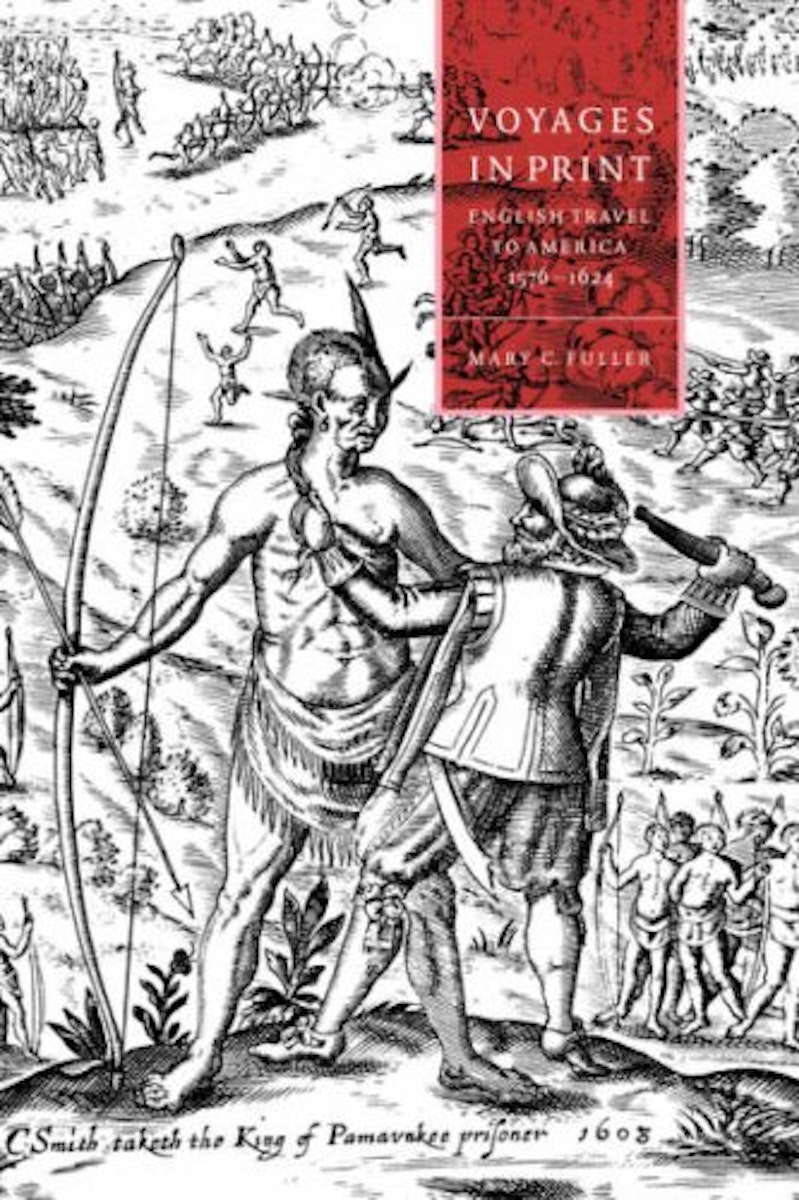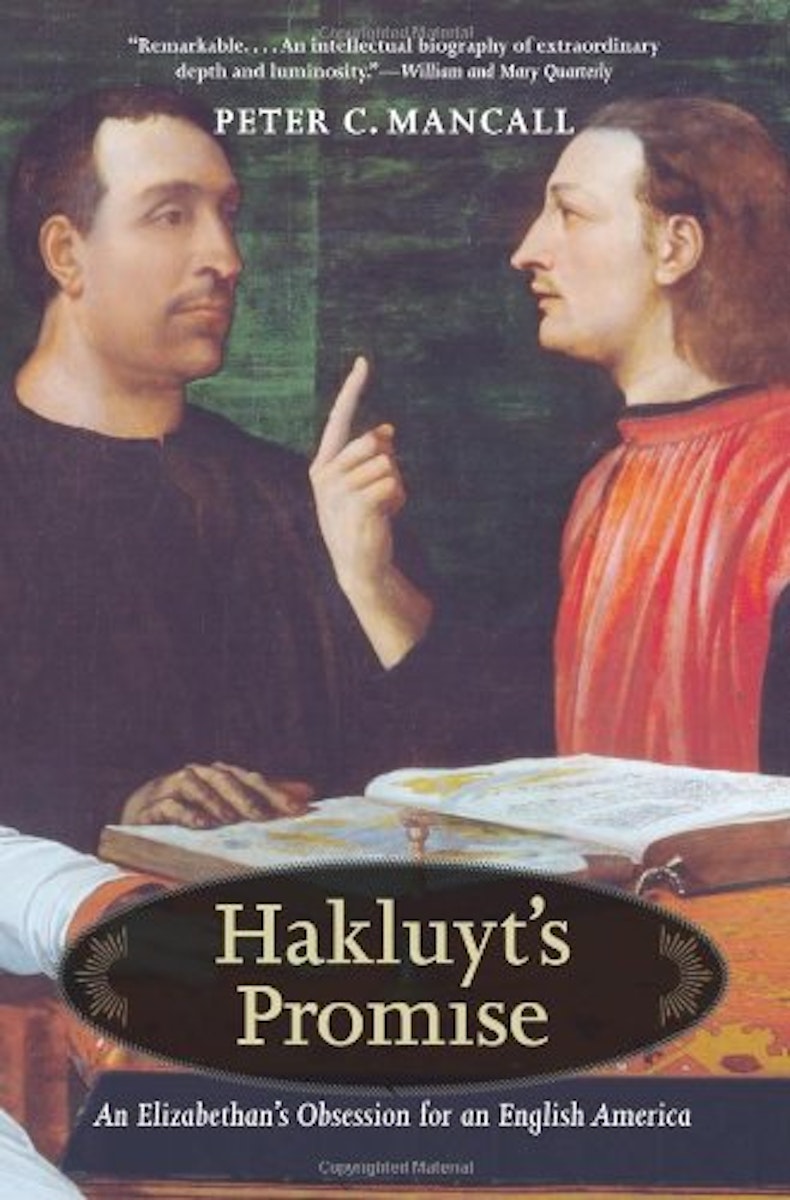
Richard Hakluyt and Early English Travel
The Principal Navigations, Richard Hakluyt's great championing of Elizabethan colonial exploration, remains one of the most important collections of English travel writing ever published. As well as the escapades of famed names such as Francis Drake and Walter Raleigh, Nandini Das looks at how the book preserves many stories of lesser known figures that surely would have been otherwise lost.
October 26, 2016
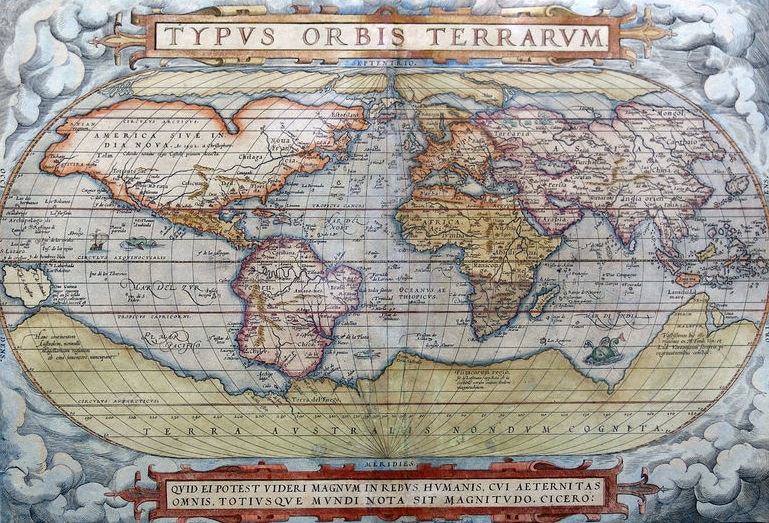 Scroll through the whole page to download all images before printing.
Scroll through the whole page to download all images before printing.Colour version of Abraham Ortelius’ Typus Orbis Terrarum, a map inserted into the first edition of Richard Hakluyt’s The Principal Navigations (1589) — Source.
In June 1586, William Harborne, the first English ambassador to the Ottoman court at Istanbul, wrote a letter. It was a tricky matter that he was trying to negotiate — the release of a few Englishmen taken prisoner by the Ottomans. The person who would decide the fate of the prisoners was Uluç Ali Pasha, the Ottoman governor (or Beglerbeg of Algiers), himself a European Christian renegade, a Calabrian who had risen from the rank of an Ottoman oar slave to become the hero of the Battle of Lepanto and the Ottoman High Admiral. Harborne’s efforts to free the English prisoners had already made him deeply unpopular with the Beglerbeg, but Harborne was not writing to him. His letter was addressed instead to the Beglerbeg’s Eunuch and Treasurer, Assan Aga, and he wrote as one Englishman to another.
Referring to the Biblical story of Joseph and his brothers in Egypt, “I trust you be ordained another Joseph”, he writes, “to folow his example in true pietie, in such sort that notwithsta[n]ding your body be subject to Turkish thraldom, yet your vertuous mind free fro[m] those vices”. In return, he would be assured of the favour of Elizabeth I and the gratitude of Harborne and his countrymen, “wherby both my selfe & others in that place having found you in all good offices faithfully affectionated, may in like case performe the like towards you, when & where you may have occasion to use me”. We do not know whether the prisoners received their freedom. Neither do we know what happened to Assan Aga, the recipient of that letter. He is only seen again, looking back at the viewer in full Turkish costume, in a chance portrait made two years later (ca. 1588) in a German traveller’s notebook. But thirteen years after Harborne wrote his letter, an English book would preserve at least a trace of who he was and who he used to be. Within its pages, a whole history of adventure, captivity, and transformation of a young man from Bristol, Samson Rowlie, son of Francis Rowlie, is condensed in a single terse headnote: “To Assan Aga, Eunuch & Treasurer to Hassan Bassa king of Alger, which Assan Aga was the sonne of Fran. Rowlie of Bristow merchant, taken in the Swalow.”
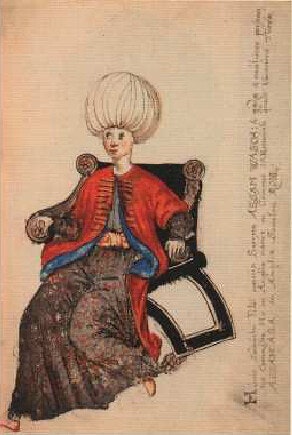 Scroll through the whole page to download all images before printing.
Scroll through the whole page to download all images before printing.The sketch of Assan Aga AKA Samson Rowlie — Source.
Harborne’s letter to the English renegade working behind the scenes of Ottoman government comes to us within the pages of what is perhaps the greatest collection of travel writing ever to be put together in any language, with a title as sonorous as the ambition behind it: The Principall Navigations, Voiages, and Discoveries of the English Nation: Made by Sea or Over Land to the Most Remote and Farthest Distant Quarters of the Earth at Any Time within the Compasse of These 1500 Years: Divided into Three Several Parts According to the Positions of the Regions Whereunto They Were Directed; the First Containing the Personall Travels of the English unto Indæa, Syria, Arabia . . . the Second, Comprehending the Worthy Discoveries of the English Towards the North and Northeast by Sea, as of Lapland . . . the Third and Last, Including the English Valiant Attempts in Searching Almost all the Corners of the Vaste and New World of America . . . Whereunto is Added the Last Most Renowned English Navigation Round About the Whole Globe of the Earth.
In years that followed, The Principal Navigations would become, in many ways, a cornerstone of Britain’s imperial ambitions, but it also serves as a unique record of figures and voices, of lives and experiences like that of Samson Rowlie, that could so easily otherwise have been lost. It seems appropriate to celebrate it this year, the 400th anniversary of the death of the man who compiled it almost single-handedly, and in the process helped to lay the foundations of a moderately-sized island nation’s rather disproportional global influence and presence in the furthest corners of the world.
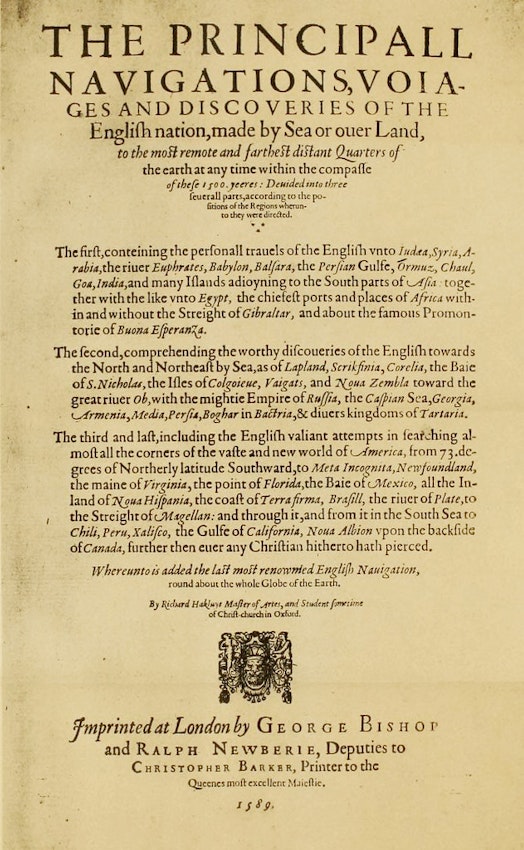 Scroll through the whole page to download all images before printing.
Scroll through the whole page to download all images before printing.The title page to the first edition of The Principal Navigations (1589), featured as a facsimile in a 1903 edition — Source.
Richard Hakluyt (1553–November 23, 1616), the orphaned second son of a Welsh family that had settled in Hertfordshire a few generations ago and supported in his studies through the benevolence of the state and guild scholarships, was introduced to the wonders of geography as a young boy through the chance glimpse of “an universal Mappe” lying on the desk of his older cousin and guardian. Later, Hakluyt would tell the story of how that impromptu lesson in the new advances in geography had ended with the Bible; his cousin and namesake, Richard Hakluyt Senior, had called upon the verses of Psalm 107, that speak of those who “go down to the sea in ships, and occupy by the great waters, they see the works of the Lord, and his wonders in the deep.” It was a claim that would have rung true for Hakluyt, growing up at a time when the expansion of European influence and trade across the world was well under way.
Elsewhere in Europe, a roll-call of great names that would become familiar to schoolchildren in ages to come had been accumulating for some time, from Marco Polo’s late thirteenth-century expeditions to China, to Vasco da Gama’s discovery of the sea route to India and the voyages of Christopher Columbus to the New World in the late fifteenth century, but those figures and narratives were merely indicative of a significantly wider surge of global awareness within Europe. English participation in that great surge, however, as an older and wiser Hakluyt would come to realise, was piecemeal, under-funded, and disorganised. English seafaring expertise was not in short supply; if the exploits of Hakluyt’s contemporaries like Martin Frobisher, Francis Drake, Walter Raleigh, and Humphrey Gilbert himself were not enough to prove their credentials, the English victory over the Spanish Armada campaign of 1588 — albeit with significant assistance from bad weather and bad tactics on the part of the Spanish — was testimony enough. But the Armada also illuminated the problems that plagued English seafaring and its future. The English fleet was an extemporary mixture of vessels, with the navy reinforced by hired and volunteer merchantmen and boats that were often better furnished and victualled than the notoriously ill-furnished royal ships. It was manned by sailors driven by very different incentives (from untried noblemen to privateers, merchant-adventurers, and fishermen volunteers), and led by men constantly fighting a losing battle against a seriously cash-strapped Exchequer and state support that either came too late or was absent altogether.
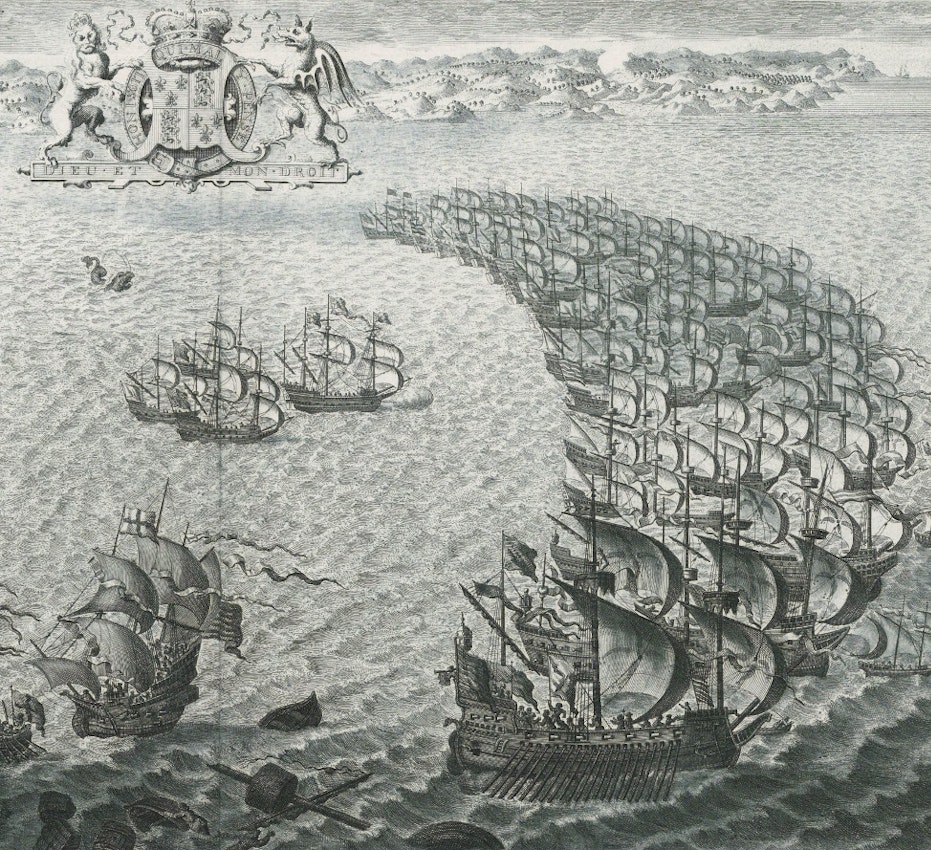 Scroll through the whole page to download all images before printing.
Scroll through the whole page to download all images before printing.Detail from an 18th-century print showing a straggle of English ships (left) up against the might of the Spanish Armada (right), the coat of arms of Queen Elizabeth hovering above. The full print features an ornamental border decorated with portraits of 22 commanders from the English fleet — Source.
The Principal Navigations was driven by Hakluyt’s acknowledgement of that neglect. In his dedicatory letter to Elizabeth I’s Principal Secretary, Sir Francis Walsingham, he tells the story of how, during his only trip abroad to the French court in 1583–88 to serve as chaplain to Sir Edward Stafford, the English ambassador, he had “both heard in speech, and read in books other nations miraculously extolled for their discoveries and notable enterprises by sea, but the English of all others for their sluggish security, and continuall neglect of the like attempts [. . .] either ignominiously reported, or exceedingly condemned.” Yet there were “few or none” who were able or willing to respond to that insult, and no one cared “to recommend to the world, the industrious labors, and painefull travels of our country men”. Hakluyt’s response, first in the folio volume of three parts in 1589 and then in the hugely expanded three monumental volumes of the second edition in 1598–1600, was meant above all to be a commemoration of those men. “For, which of the kings of this land before her Majesty, had theyr banners ever seene in the Caspian sea?” he asks rhetorically in that letter to Walsingham.
Which of them hath ever dealt with the Emperor of Persia as her Majesty hath done, and obtained for her merchants large and loving privileges? who ever saw before this regiment, an English Ligier in the stately porch of the Grand Signor at Constantinople? who ever found English Consuls and Agents at Tripolis in Syria, at Aleppo, at Babylon, at Balsara, and which is more, who ever heard of an Englishman at Goa before now? what English shippes did heretofore ever anker in the mighty river of Plate? passe and repasse the unpassable (in former opinion) straight of Magellan, range along the coast of Chili, Peru, and all the backside of Nova Hispania, further than any Christian ever passed, travers the mighty bredth of the South sea, land upon the Luzones in despight of the enemy, enter into alliance, amity, and traffike with the princes of the Moluccaes, and the Isle of Java, double the famous Cape of Bona Speranza, arive at the Isle of Santa Helena, and last of al returne home most richly laden with the commodities of China, as the subjects of this now flourishing monarchy have done?
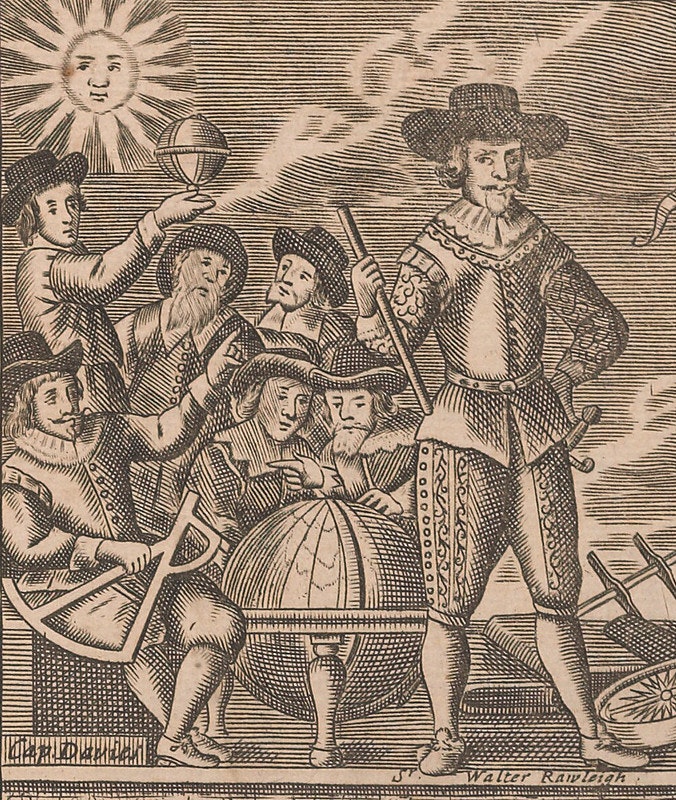 Scroll through the whole page to download all images before printing.
Scroll through the whole page to download all images before printing..
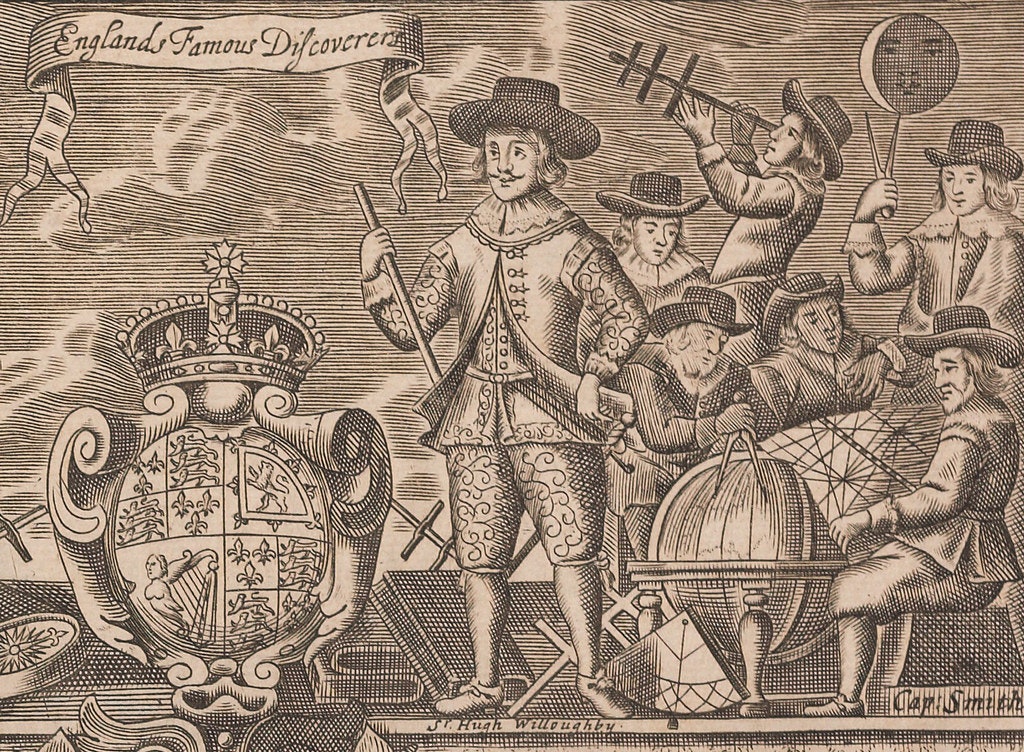 Scroll through the whole page to download all images before printing.
Scroll through the whole page to download all images before printing.Details from the engraving England’s Famous Discoverers, as it appears in the title page of The Coasting Pilot (ca. 1677) by John Seller — Source.
Hakluyt’s paean of praise is quite an effective preview of the treasures in store within the pages of his volume, but what made The Principal Navigations both unusual and path-breaking was not just its immense range or its focus (Hakluyt promised in his introductory letter to the reader that he would “meddle in this worke with the Navigations onely of our owne nation”) — it was its approach. When Hakluyt came to compile his collection, he had, essentially, two models to follow. The first of these were the books published by writers like the German geographer Sebastian Münster, who had built their reputations by compiling what Hakluyt rather waspishly dismissed in The Principal Navigations as “wearie volumes . . . of universall Cosmographie”. These were magisterial geographical descriptions of the world seen through the heuristic lens of Christian doctrine, which mixed classical and medieval authorities, often fairly indiscriminately, with snippets of data gathered from contemporary travel. The second was offered by European scholars like Giovanni Battista Ramusio and Peter Martyr d’Anghiera, or the English Richard Eden. These were men whom Hakluyt admired, who depended far more on current first-hand accounts (although often through translation and summary) than on the second-hand redactions of the old cosmographies. But they focused mostly on non-English sources. Beyond these texts in print, however, thousands of documents circulated in private correspondence at home and abroad, and in the papers of the English trading companies: a store of both foreign and English voices, fleeting, scattered, incomplete, immensely vulnerable to both time and human carelessness.
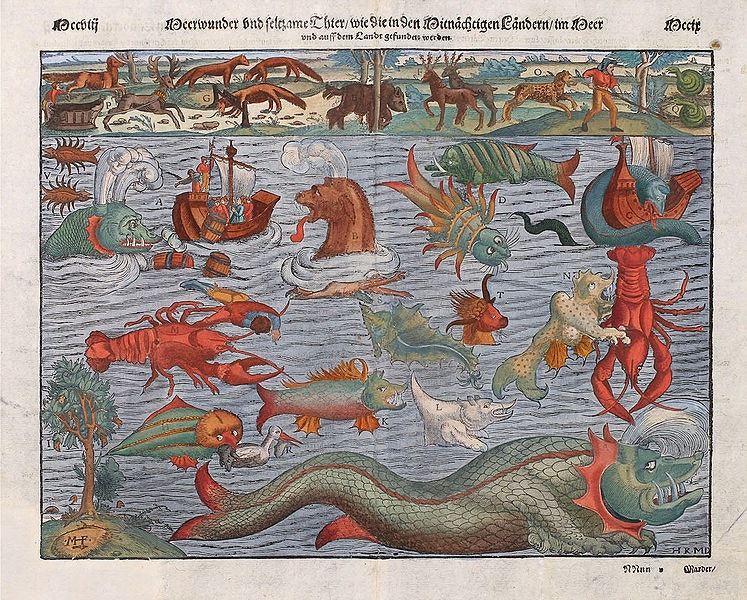 Scroll through the whole page to download all images before printing.
Scroll through the whole page to download all images before printing.Sebastian Münster’s sea monster chart (1544 and after), composed from copies of the vignettes found in Olaus Magnus’s Carta Marina — Source.
These are the voices that The Principal Navigations preserves. Hakluyt’s advertised aim, as he declares in his preface, was to allow “those men which were the paynefull and personall travellers [to] reape that good opinion, and just commendation which they have deserved, and further that every man might answere for himselfe, justifie his reports, and stand accountable for his owne doings, [he had] referred every voyage to [its] Author, which both in person hath performed, and in writing hath left the same”. “Whatsoever testimonie I have found in any author of authoritie appertaining to my argument, either stranger or naturall”, he notes, “I have recorded the same word for word, with his particular name and page of booke where it is extant.”
Among the pages of The Principal Navigations, therefore, we find texts like Thomas Stevens’ letter to his father. In the correspondence, Stevens — an English Catholic who escaped to Rome to train as a Jesuit priest, and became the first Englishman in 1579 to reach Goa — described what lay in store for sailors in the tricky passage around the Cape of Good Hope: “Their gums waxe great and swell, and they are faine to cut them away, their legs swell, and all the bodies becommeth sore, and so benummed, that they cannot stirre hand nor foot, and so they die of weaknesse, others fall into fluxes and agues, and die thereby.” A decade later, in his account of a journey to Benin in 1588 in search of the lucrative pepper trade, Anthony Ingram describes how after a long journey and despite collecting 64 serons (one seron is roughly 6–7 lbs) of pepper and 28 elephants’ teeth, they struggle to get the goods to the ship because the men are so weakened by “the disease of the fever”.
There are wonders: Dionyse Settle’s first person account of Martin Frobisher’s 1577 voyage to northeastern Canada records a glimpse of icebergs and a dead narwhal, whose single tusk, “of length two yards lacking two inches,” made the sailors conclude that they had seen a “sea unicorn”. There is the tedium of travel and tragedy: Stephen (or István) Parmenius’ letter to Hakluyt himself, dated August 1583, records his disappointment on arrival at St John’s Harbour as a member of the crew on Sir Humphrey Gilbert’s voyage to Newfoundland. “The trees for the most part are Pynes”, Parmenius wrote, and “all the grasse here is long, and tall, and little differeth from ours.” There were no wonders, not even a single mermaid — even though they were supposed to be around (Theodore de Bry’s America would depict them at St John’s Harbour a few years later). And the “island which your men call Penguin because of the multitude of birdes of the same name”? Well, grumbled Parmenius, “wee neither sawe any birds, nor drew neere to the land, the winds serving for our course directed to another place”. He was referring, of course, to the Great Auk — unrelated to the penguin, although it was the first bird to be called penguin — which was to become extinct by the 1840s due to overenthusiastic hunting by early explorers. When they had stocked up on supplies “in this place”, Parmenius hoped, “we purpose by the helpe of God to passe towards the South”, to the greater things “that are reported of those Countreys, which we go to discover.” But Hakluyt would have known the end of that particular story. Bookish, earnest young Parmenius was lost at sea just weeks after writing his letter, like Sir Humphrey Gilbert himself. Only two of the five ships had returned, carrying their own reports and those of the lost men.
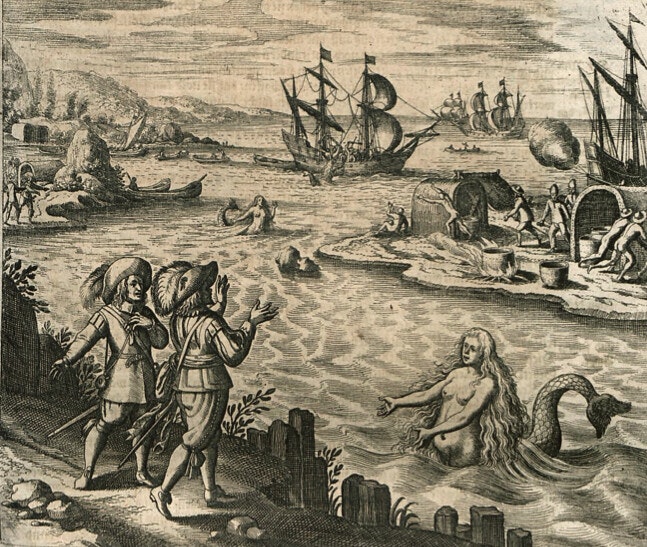 Scroll through the whole page to download all images before printing.
Scroll through the whole page to download all images before printing.Theodore de Bry’s image of a mermaid in St John’s Harbour, as featured in Johann Ludwig Gottfried’s Histora Antipodum oder Newe Welt (1631) Source.
Hakluyt organised such documents alongside more formal, historical accounts and reports, chronologically and in three parts according to region (so the first document is an account of King Arthur’s supposed conquest of Iceland in C.E. 517, and the last is Hakluyt’s own translation of a report on Spanish navigation that was provided by a captured Spanish pilot Pedro Diaz, dated February 1586). He also divided them according to type, under two separate headings: the “Voyages” themselves, and official documents, information, and correspondence connected with those voyages, the “Ambassages, Treatises, Priviledges, Letters and observations” that often supplement, interrogate, and occasionally contradict the stories told in the narratives that accompany them.
His first edition in 1589 ran to over eight hundred densely-packed folio pages. By 1600, the second edition had grown even bigger, running to over 1,760,000 words in three folio volumes and about two thousand pages. And this was not all. At the same time as he was collecting this huge expanse of material, others published their own accounts and translations with Hakluyt’s encouragement: Thomas Hariot, who wrote about his influence in The Briefe and True report of the new found land of Virginia (1590) and John Pory, who claimed that Hakluyt was “the onely man that mooued [him] to translate” John Leo Africanus’ History of Africa, were two among many. Hakluyt’s own translations included, among others, the Dutch jurist Hugo Grotius’ enormously influential treatise, the Mare liberum (The Free Sea or The Freedom of the Seas), which argued that no nation could impose restrictions on seafaring trade since the sea did not belong to any single nation. His reports on trade opportunities and commodities, navigation conditions, and local inhabitants were commissioned by London’s growing trading companies like the Virginia Company and the East India Company, while The Principal Navigations became one of those books that their ships were recommended to carry as essential reading. By the time of his death, Hakluyt’s work and advocacy of Protestant English settlements and colonies in the New World, both in writing and as an advisor to the state and the trading companies, had become the cornerstone of English colonial and imperial plans and established the legacy of English explorations in general.
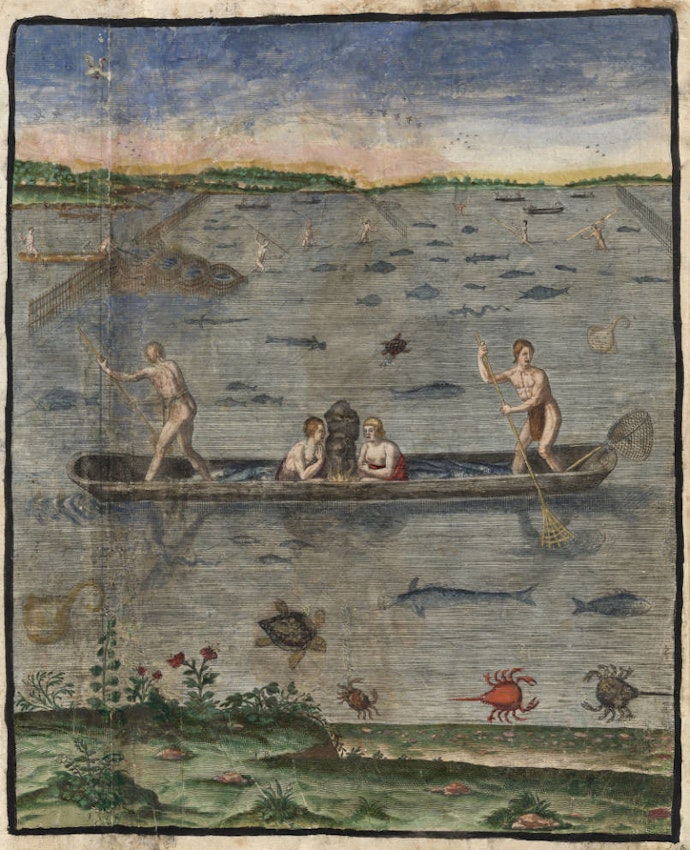 Scroll through the whole page to download all images before printing.
Scroll through the whole page to download all images before printing.Coloured engraving showing Native Americans fishing, from Theodor De Bry’s illustrated 1590 edition of A Briefe and True Report of the New Found Land of Virginia by Thomas Hariot — Source.
Hakluyt died on November 23, 1616. He was buried in Westminster Abbey, although the exact location of the burial site is now lost. At the height of the British Empire, Victorian scholars like the historian J. A. Froude understandably celebrated his work as the great “prose epic of the modern English nation”, and the eponymous Hakluyt Society was established with the aim to follow his example in publishing accounts of travel and exploration, an aim it continues to pursue to this day. In recent years, however, both The Principal Navigations and Hakluyt himself have started to demand our attention yet again, but perhaps not for quite the same reasons. Hakluyt’s legacy was not just a nationalistic celebration of English imperial ambitions. The Principal Navigations memorialises not just the successes of English travels, the great figures and great wonders, but also the elusive traces of those who disappeared, the disappointment of the non-event, the tedium of travel, and the absence of wonder. Beyond the great figures of Raleigh, Frobisher, and Gilbert, beyond the pioneering circumnavigations of Drake and Cavendish, Hakluyt’s collection stands testimony to the ordinary traveller and the individual experience of travel — fragile, unexpected, and so often hostage to fortune. From shadowy figures like Samson Rowlie, “taken in the Swallow” and transformed into Assan Aga, the Ottoman eunuch treasurer, to voices like that of young Parmenius of Buda, who had hoped to write a new Latin epic, did not get to see the penguins, and sunk with a ship called The Delight, Hakluyt’s Principal Navigations bears witness to the lives of hundreds of travellers, without whom the story of “English” travels and voyages would be much the poorer.
Nandini Das is a literary and cultural historian, and Professor of English Literature at the University of Liverpool, UK. In multiple essays and books such as Robert Greene’s Planetomachia (2007), Renaissance Romance: The Transformation of English Prose Fiction, 1570-1620 (2011), and Enchantment and Dis-enchantment in Shakespeare and Early Modern Drama, co-edited with Nick Davis (2016), she has explored the genre of romance, Renaissance prose fiction, and the place of the everyday in late sixteenth century literature.





